Defining climate and sustainability targets and the global action needed to reach them
Although climate scientists around the world have been issuing warnings about climate change since the 1980s, actions to counteract it are still far from being on track.
Without immediate and bold action, we will see a dramatic increase in the global average temperature. As a result, entire populations will be forced to adapt or—where adaptation is not possible—to abandon their homes. Based on scientific advice, most countries in the world have agreed on climate targets to counteract this dramatic warming trend; however, progress is slow. Renewable energy, including sustainable bioenergy, is needed to transform our energy systems, economies, and society as a whole. The good news is that we have the knowledge, technologies, and strategies to achieve this.

We need to act urgently on climate change. Only the adoption of sustainable strategies can make our planet “liveable”. (Photo credit: Unsplash/ Markus Spiske)
The current commitments to limit global warming
Probably the best-known commitment to combating climate change is the Paris Agreement, a legally binding international treaty on climate change, adopted by 196 Parties at the 21st Conference of the Parties (COP 21) to the United Nations Climate Change Framework Convention held in Paris in 2015. The goal of the Paris Agreement is to limit global warming to well below 2°C, preferably to 1.5°C, compared to pre-industrial levels. To achieve this, countries aim to reach global peaking of greenhouse gas emissions as soon as possible, and thus achieve a carbon- neutral world by mid-century. By 2020, countries submitted their action plans for reducing GHG emissions in accordance with the goals of the Paris Agreement. Countries also communicated theirfuture resilience-building strategies to help them adapt to the impacts of rising temperatures.
The most recent commitment to climate goals was made at the 26th Conference of the Parties (COP26) held in Glasgow in November 2021. COP 26 led to the adoption of the Glasgow Climate Pact, which aims to turn the 2020s into a decade of climate action and support. As adaptation to the impacts of climate change is now deemed to be of equal importance to emission reductions, a work programme on climate change adaptation has been developed.
Moreover, with this in mind, governments of developed countries have committed to providing 100 billion US dollars annually to developing countries. Nations also agreed to work to reduce the gap between existing emission reduction plans and the measures required to actually reduce emissions to meet the 1.5°C global warming target. Most importantly, the Glasgow Pact calls upon nations to phase out unabated coal power and inefficient subsidies for fossil fuels.
Further commitments to an even faster transition to renewable energies can be expected in the near future. This is in response to recent geopolitical events that have brought energy security
and diversity of energy supply chains back into focus.
Roadmap to decarbonise global economy
Currently, of the 33 sectors monitored by the International Energy Agency (IEA), only two (electric vehicles and lighting in buildings) are on track to reach the climate targets; more efforts are needed in renewable power, hydrogen, and many other sectors; more than half the sectors, including transport biofuels, aviation, and international shipping, are significantly lagging behind.
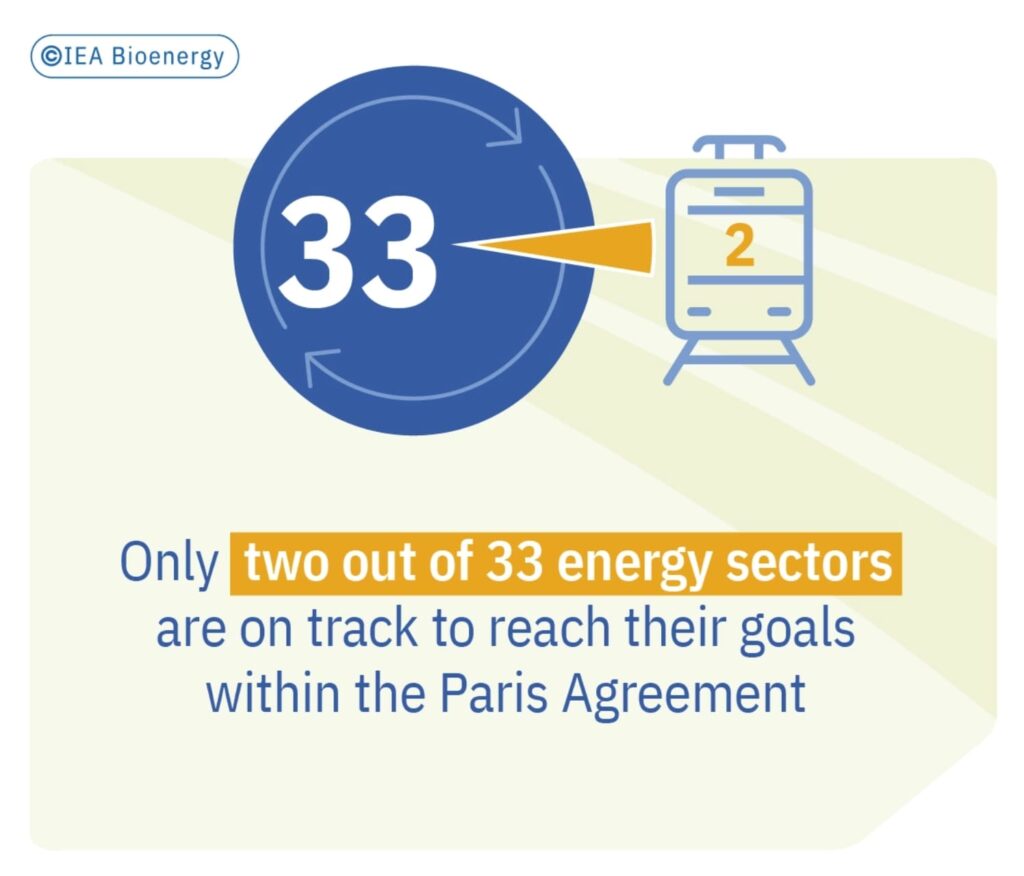
According to the IEA, the world needs to shift rapidly away from fossil fuels, and the energy sector—being the major source of global fossil emissions—has a key role to play in this. The energy sector needs to be transformed to increase energy conservation, use energy more efficiently, produce and use a greater amount of renewable energy, and deploy carbon capture, utilisation, and storage (CCUS) to avoid carbon emissions to the atmosphere.
Key energy carriers are sustainably produced electricity, biofuels, and hydrogen. The active involvement and engagement of citizens in deploying these low-carbon technologies as well as behavioural changes can strongly contribute to emission reductions.
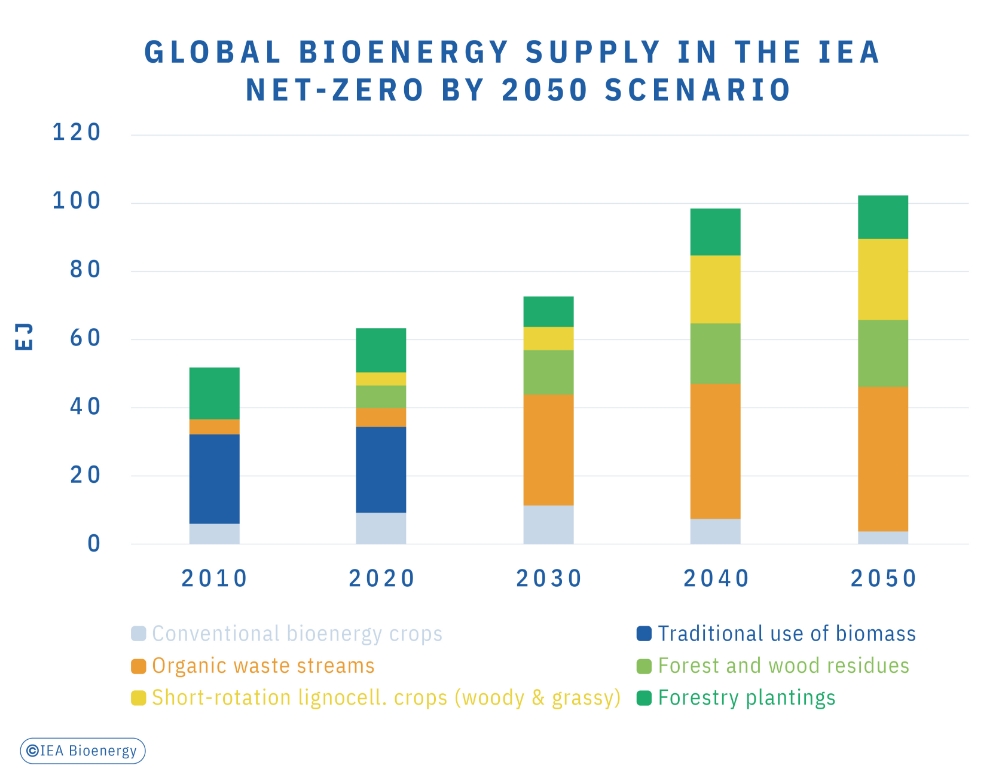
In the scenario that leads to net zero CO2 emissions from the energy sector by 2050, the energy analysts of the IEA expect bioenergy to represent 18% of the total energy supply in 2050. The year 2050 will also see bioenergy providing 15% of energy consumption in industry (mainly high temperature heat), 16% of transport energy consumption, 10% of energy consumption in buildings (direct use), as well as negative emissions through bioenergy carbon capture and storage (BECCS) of 1.3 billion tonnes CO2 per year.
This, however, is not a self-starter scenario. It will require massive efforts to scale up deployment of sustainable bioenergy to the required levels.
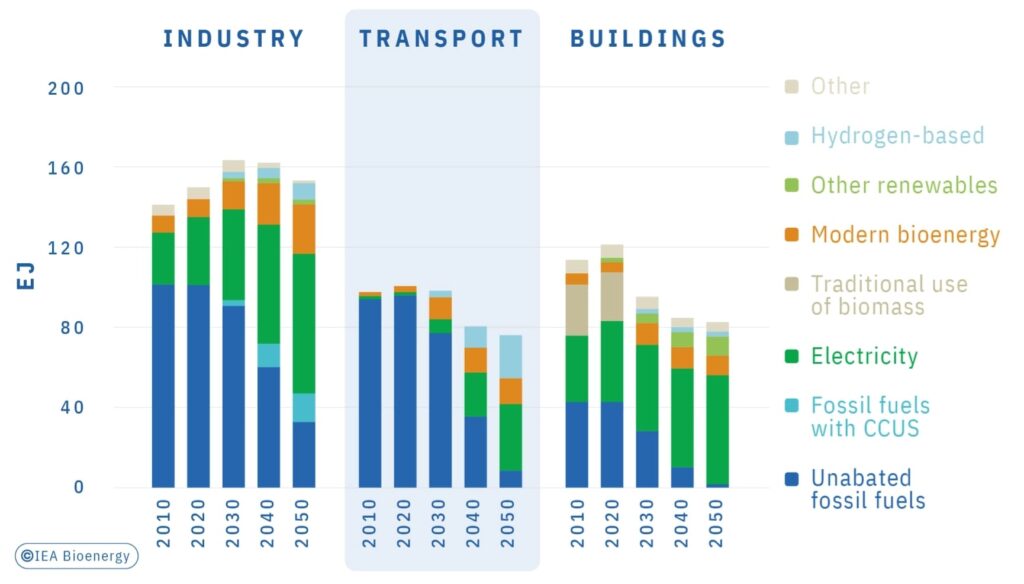
A long path towards consensus: IPCC, the Paris Agreement, and the Sustainable Development Goals
Intergovernmental action to address climate change began in 1990, when several hundred scientists involved in preparing the “Climate Change” report for the Intergovernmental Panel on Climate Change (IPCC) stated with certainty that a natural greenhouse effect was warming Earth to a greater than normal extent and that emissions resulting from human activities were causing a substantial increase in the atmospheric concentrations of the greenhouse gases carbon dioxide, methane, chlorofluorocarbons, and nitrous oxide. Such increases would enhance the greenhouse effect, resulting overall in an additional warming of Earth’s surface.

In response to this warning by scientists, in 1992, the “Earth Summit” was held in Rio de Janeiro, bringing together political leaders, diplomats, representatives of academia, the media, and non-governmental organisations from 179 countries in a massive effort to focus on the impact of human socio-economic activities on the environment.
The Earth Summit led (among other things to) the Convention on Biological Diversity (CBD) and to the foundation of the United Nations Framework Convention on Climate Change (UNFCCC),as well as the adoption of the Kyoto Protocol in 1997 and the Paris Agreement in 2015. The ultimate objective of all these efforts was to stabilise GHG concentrations in the atmosphere at a level that would “prevent dangerous human interference with the climate system, in a time frame which allows ecosystems to adapt naturally and enables sustainable development” (UNFCCC Secretariat).
Through the Kyoto Protocol, which was adopted in 1997 and entered into force in 2005, industrialised countries and economies in transition committed to an average 5% reduction in emissions compared to 1990 levels over the period 2008–2012. In 2012, the Doha Amendment to the Kyoto Protocol was adopted for a second commitment period, running from 2013 to 2020, and was finally ratified by 2020. Even though the Kyoto Protocol did not greatly reduce global GHG emissions, it paved the way for the Paris Agreement to limit the global temperature rise to well below 2°C above pre-industrial levels, and thereby avoiding tremendous economic, social, and environmental disruption and costs.

The scientific evidence of global warming continues to strengthen further and to confirm the impact of human activities on the mean temperature of Earth. In its 6th Assessment Report (AR6) on adaptation (Working Group II) and mitigation (Working Group III), the IPCC describes the current negative impacts of climate change, deforestation, land use change, and pollution
on people and the planet. The authors of AR6 stress the urgency of immediate action to address climate risks that goes well beyond current ambitions. They emphasise the pressing need for systemic transitions in a number of areas: energy; land and water ecosystems; urban and rural areas; infrastructure; industry; and society.
The contributions of Working Groups II and III recognise the important role of the bioeconomy within these urgent and deep transitions. The report stresses: “Bio-based products as part of a circular bioeconomy have potential to support adaptation and mitigation, with sectoral integration, transparent governance and stakeholder involvement key to maximizing benefits and managing trade-offs”. (IPCC_AR6_WGII_FinalDraft_FullReport.pdf)
In an urban environment this could see the integration of waste and energy streams, while in a rural environment, agroecology would become more important: “Agroecology can support long-term productivity and resilience of food systems by sustaining ecosystem services such as pollination, soil organic carbon, pest and weed control, soil microbial activity, crop yield stability, water quality and biodiversity.” (WG2AR6_FD_TS_FINAL (ipcc.ch))
The report also sees a substantial role for bioenergy: “Strategic integration of appropriate biomass production systems into agricultural landscapes can provide biomass for bioenergy and other biobased products while providing co-benefits such as enhanced landscape diversity, habitat quality, retention of nutrients and sediment, erosion control, climate regulation, flood regulation, pollination and biological pest and disease control.” (Climate Change 2022: Mitigation of Climate Change (ipcc.ch)) However, the report also raises concerns regarding bioenergy and its land use as part of a carbon dioxide removal (CDR) technology (i.e., BECCS) and regarding the potentially inappropriate development of bioenergy that could accompany large-scale implementation.
In its special report “Global Warming of 1.5°C” scientists continue to provide evidence that human activities have already caused approximately 1.0°C of global warming above pre-industrial levels and that this has already caused irreversible damage to ecosystems and livelihoods around the world. Impacts include: i) increase in mean temperatures in most land and ocean regions; ii) hot extremes in most inhabited regions; iii) heavy precipitation in several regions; and iv) the probability of drought and precipitation deficits in some regions. Limiting warming to 1.5°C is not impossible, but it will require unprecedented transitions in all aspects of society. There are clear benefits to keeping warming to 1.5°C compared to 2°C or higher, as frequencies and intensities of temperature-related extremes increase with increasing global warming—every bit of warming matters. (Foreword — Global Warming of 1.5 oC (ipcc.ch))
Another IPCC report, “Climate Change and Land” investigated the utilisation of land for food, feed, and bioenergy; it found that the land we are already using for cultivation could feed the world in a changing climate and, at the same time, provide biomass for material applications and renewable energy. This would require early and far-reaching action to be taken across several fronts, including improved crop management, reduced deforestation, measures for removing CO2 from the atmosphere, and people shifting to plant-based diets. Better land management can play its part in tackling climate change, but it cannot do everything.
Another strand of intergovernmental collaboration, brought up at the UN Conference on the Human Environment in Stockholm in 1972, and further strengthened through the 1992 Earth Summit, is the striving for peace and prosperity among all people and for the planet, both now and into the future. Eradicating poverty in all its forms and dimensions, including extreme poverty, is a global challenge and an indispensable requirement for sustainable development. Following several summits of the United Nations, in 2015 the 2030 Agenda for Sustainable Development was adopted by all United Nations Member States. At the core of this agenda are the 17 Sustainable Development Goals (SDGs). These goals and the 169 targets within the agenda are integrated and indivisible and in balance with the three dimensions of sustainable development: economic, social, and environmental. All efforts to combat climate change should be undertaken in the light of the SDGs and should aim for a just transition into a sustainable future.
- United Nations Climate Change, The Paris Agreement LINK accessed 18/02/2022
- COP 26 United Nations Climate Change Conference UK 2021 LINK accessed 18/02/2022
- United Nations Climate Change, The Glasgow Climate Pact – Key Outcomes from COP26 LINK accessed 18/12/2022
- IEA International Energy Agency, Tracking Clean Energy Progress Assessing critical energy technologies for global clean energy transitions LINK accessed 18/02/2022
- IEA (2021) Net Zero by 2050 A Roadmap for the Global Energy Sector LINK accessed 18/02/2022
- IPCC Intergovernmental Panel on Climate Change (1990) Climate Change: The IPCC Scientific Assessment LINK accessed 18/02/2022
- IPCC Intergovernmental Panel on Climate Change LINK accessed 18/02/2022
- United Nations, United Nations Conference on Environment and Development, Rio de Janeiro, Brazil, 3-14 June 1992 LINK accessed 20/06/2022
- United Nations Climate Change, Bonn Climate Change Conference – June 2022 LINK accessed 18/02/2022
- United Nations Climate Change, What is the Kyoto Protocol? LINK accessed 20/06/2022
- United Nations Climate Change, The Doha AmendmentLINK accessed 20/06/2022
- IPCC (2022) AR6 Synthesis Report: Climate Change 2022 LINK accessed 20/06/2022
- United Nations, United Nations Conference on Environment and Development, Rio de Janeiro, Brazil, 3-14 June 1992 LINK accessed 18/02/2022
- IPCC (2022) Climate Change 2022 – Mitigation of Climate Change LINK accessed 20/06/2022
- IPCC (2018) Global Warming of 1.5°C. An IPCC Special Report on the impacts of global warming of 1.5°C above pre-industrial levels and related global greenhouse gas emission pathways, in the context of strengthening the global response to the threat of climate change, sustainable development, and efforts to eradicate poverty [Masson-Delmotte, V., P. Zhai, H.-O. Pörtner, D. Roberts, J. Skea, P.R. Shukla,A. Pirani, W. Moufouma-Okia, C. Péan, R. Pidcock, S. Connors, J.B.R. Matthews, Y. Chen, X. Zhou, M.I. Gomis, E. Lonnoy, T. Maycock, M. Tignor, and T. Waterfield (eds.)]. In Press. LINK accessed 18/02/2022
- IPCC (2019) Climate Change and Land: an IPCC special report on climate change, desertification, land degradation, sustainable land management, food security, and greenhouse gas fluxes in terrestrial ecosystems [P.R. Shukla, J. Skea, E. Calvo Buendia, V. Masson- Delmotte, H.- O. Pörtner, D. C. Roberts, P. Zhai, R. Slade, S. Connors, R. van Diemen, M. Ferrat, E. Haughey, S. Luz, S. Neogi, M. Pathak, J. Petzold, J. Portugal Pereira, P. Vyas, E. Huntley, K. Kissick, M. Belkacemi, J. Malley, (eds.)]. In press. LINK accessed 18/02/2022
- United Nations, United Nations Conference on the Human Environment, 5-16 June 1972, Stockholm LINK accessed 18/02/2022
- United Nations Department of Economic and Social Affairs Sustainable Development, Sustainable development goals LINK accessed 18/02/2022
Modern sustainability avenues
The different energy pathways to sustainability in a world in transition from a circular bioeconomy to renewable carbon and green hydrogen.
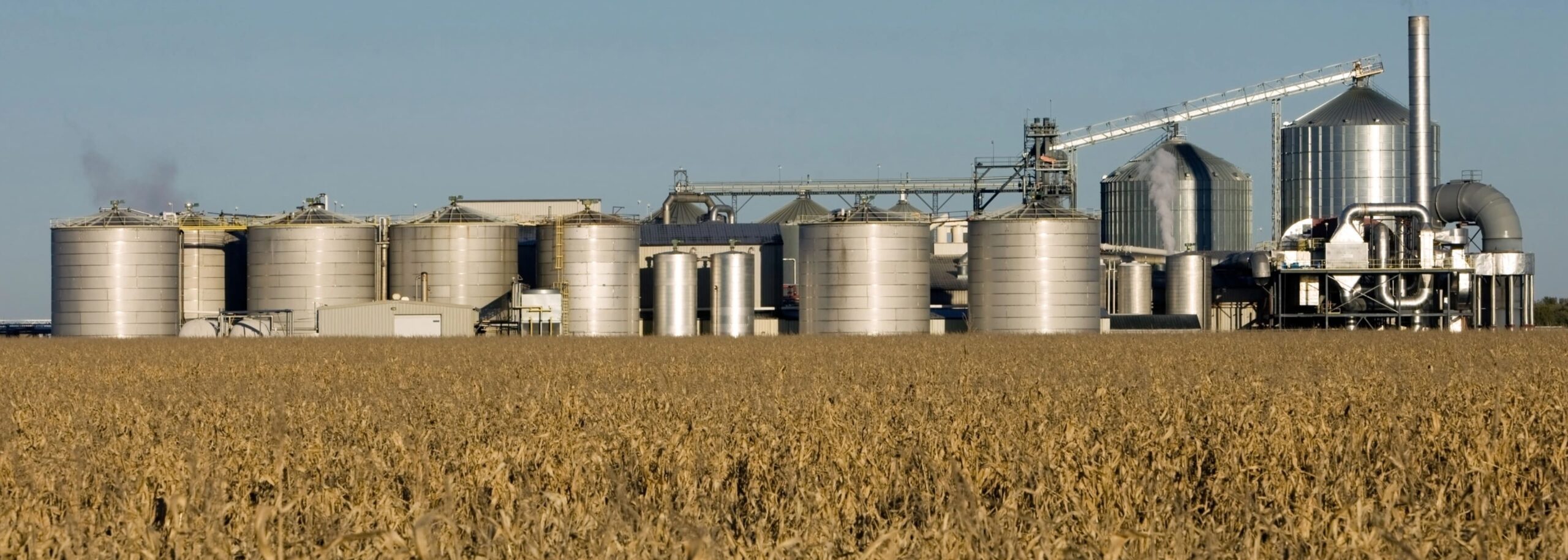
Moving towards establishment of a greater number of integrated biorefineries can be an important step in transitioning to a more circular bioeconomy. (Photo credit: Gettyimages/BanksPhotos)
Transition to renewable carbon, circular material use, and green hydrogen
The rapidly closing window of opportunity for reaching the Paris 2015 climate goals and for halting the dramatic decline in numbers and abundance of species are the most visible dimensions of the urgent need to achieve sustainability. Paradoxically, however, the pressing need to open avenues to sustainability is at odds with ambitious biodiversity targets.
At the same time, many regions are desperate to further develop their economies and societies by providing universal access to clean energy and public goods and services, including those related to food, water, and health.
The challenge is to close the gaps in energy provision, while at the same time decreasing GHG emissions. Several routes to achieving sustainability are currently being discussed both within the scientific community and at the policy level. Different successful and promising pathways and strategies have also been identified and pursued in different world regions.
Renewable carbon
Sustainable biomass can be a substitute for fossil fuels in a number of difficult-to-decarbonise sectors such as transport and industry. Countries like Brazil and the USA, for example, have long been embarked on a pathway to scale up biofuels. Moreover, the chemical industry will always be in need of carbon as an input—ultimately, this carbon either has to be captured from the atmosphere or come from renewable and sustainable biomass, as fossil resources continue being phased out.
The maximum impact of renewable carbon avenues will, however, be limited by the overall availability of biomass.
A recent example of the role of biomass in a net zero emissions European Union (EU), a report by a sustainability consultancy, indicates that under current policy plans, pathways of biomass for material and energy use would require 40–100% more biomass than is likely to be available in Europe. In its conclusion, the report urges EU policymakers to carefully consider biomass use in the context of its highest value; this is also reflected in the EU’s Fit for 55 package, which includes a proposal to amend the Renewable Energy Directive to cover the cascading use of biomass. The cascade chain would allocate high-quality woody biomass first to long-lived products, such as building materials, then to refurbishment, and eventually to reuse and recycling, before ending up in an energetic use. Residues (low quality) from biomass processing (e.g., dust from sawmilling) can be used for direct energetic conversion, if there are no other options for their material application.
Circular bioeconomy
The understanding of circular bioeconomy (CBE) as an essential part of a wider circular economy can differ across stakeholders, countries, and even among scientists. A recent review of a number of bioeconomy clusters found that they are increasingly using residues and wastes, moving towards more integrated biorefineries production models (see also IEA Bioenergy Task 42: Biorefining in a Circular Economy), and focusing first on material and higher-value applications of biomass.
While these are signs of a trend towards a CBE, circular product design, recycling, and cascading are marked by large research gaps. Recent research identifies implementation policies and regulations, costs, and the current small size of bio-based markets as key challenges for a CBE. Furthermore, when shifting to CBE or any other new pathway such as hydrogen or a cascading system, trade-offs need to be considered, as other existing biomass usages might be more sustainable (in terms of net GHG emissions savings). Presently, the social aspects, cascading, circular product design, and aspects related to product use are especially underrepresented in the CBE literature.
Expansion of Solar PV and Wind
According to recent IEA assessments, renewables have grown rapidly in recent years, driven by policy support and sharp cost reductions for solar photovoltaics (PV) and wind power in particular. Yet, electricity accounts for only a fifth of global energy consumption, and the role of renewables in the transportation and heating sectors remains critical to the energy transition.
In 2020, renewable electricity generation rose by 7%, with wind and solar PV technologies together accounting for almost 60% of this increase. However, according to the IEA’s Net Zero Emissions by 2050 scenario (NZE), renewable power deployment as a whole still needs to expand significantly to achieve Net Zero Emissions by 2050. This pathway would require growth, from a share that is presently 27% of power generation, to a share of more than 60% by 2030.
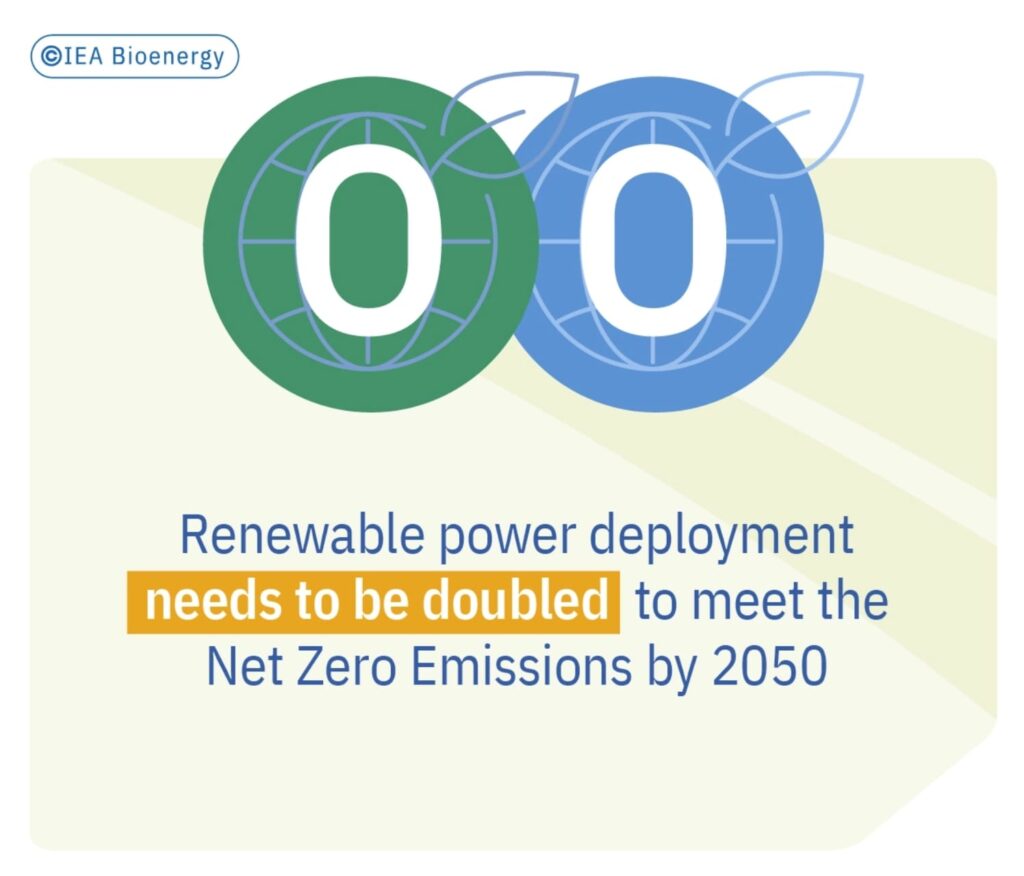
In a significant majority of countries worldwide, solar PV is becoming quite an important economic option in terms of adding new electricity generation capacity, especially amid rising natural gas and coal prices; its importance is also due to improved storage and reduced spare capacity needs to make up for the intermittency of PV. Meanwhile, policy initiatives in China, India, and the European Union are boosting the deployment of commercial and residential PV projects. To reach Net Zero Emissions in the energy sector by 2050, however, PV would need to see an almost fivefold increase in annual deployment until 2030, according to the IEA. This will require much greater policy ambition and more efforts from both public and private stakeholders, especially in the areas of grid integration and the mitigation of policy, regulation, and financing challenges— and particularly in emerging and developing countries.
The IEA World Energy Outlook for 2021 states that clean electrification is a central element of decarbonising the energy sector, including all sustainability avenues and energy pathways, but it is not possible to electrify everything. In the IEA Net Zero Emissions scenarios, although overall electricity production increases impressively by a factor of 2.5 compared to current levels, it still comprises less than 50% of total final energy consumption in 2050. This means that liquid, gaseous, and solid fuels of various types will continue to make major contributions to the global energy mix through to 2050.
Renewable Hydrogen
Another route that has enjoyed a wide push by a large variety of policies and initiatives across the world has been towards renewable hydrogen. According to IEA statistics, 23 governments plus the EU have published low-carbon hydrogen strategies and more than 20 countries are already developing them. While these strategies focus mainly on targets for hydrogen supply, attention is increasingly being paid to the policies needed to stimulate demand for both renewable hydrogen and hydrogen-based liquids, including ammonia, methanol, and other synthetic liquid hydrocarbons with very low emission intensities.
While green hydrogen (from renewable sources) can be produced through electrolysis, this is still quite a costly route. Thus, the transition from fossil fuel–based hydrogen production to renewable hydrogen production is also likely to include other low-carbon energy carriers. In the IEA’s Net Zero Emissions scenario, around half of low-carbon hydrogen production in 2030 is from electrolysis and the remainder is from coal and natural gas equipped with CCUS (although this ratio varies considerably among countries).
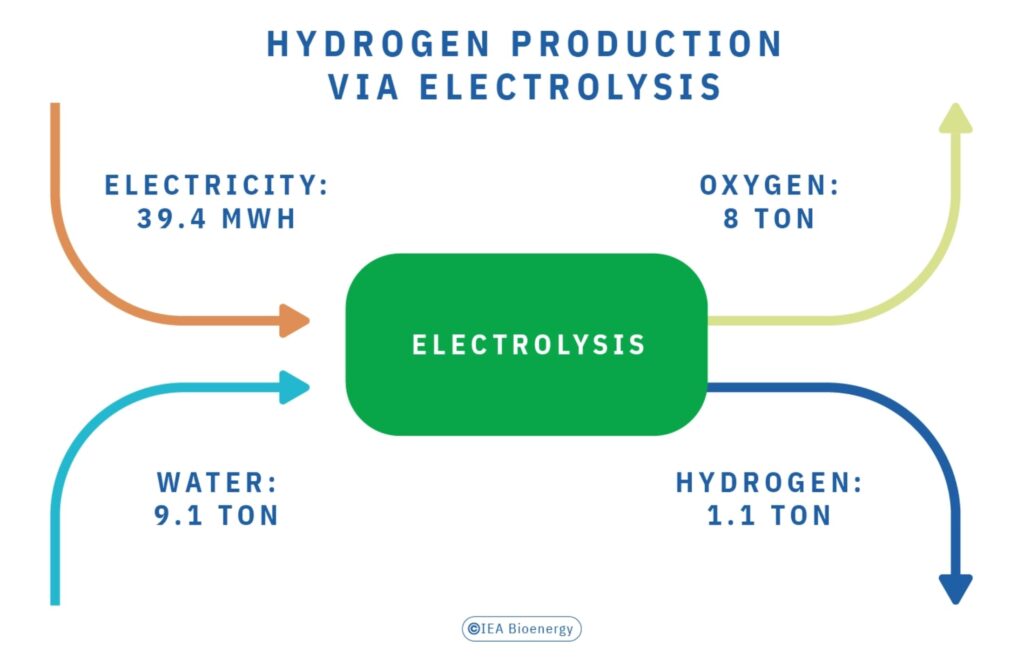
Choosing between different options
Biomass, while available in limited supply, is renewable and can serve all sectors (industry, power, heat, transport). Hence, its use has to be targeted at where it creates the highest value, not only economically, but also in terms of reducing net carbon emissions, while also respecting other SDGs.
Rather than choosing between different options, a complementary approach is needed—tapping into biomass for renewable carbon, moving further towards a circular economy to maximise the use of a limited resource, and helping mitigate climate change/reduce GHG emissions.

Different regions will choose different strategies for doing this. For example, as fuel costs make up the bulk of current production, Russia, the Middle East, and North America have a head start in fossil-based (grey) hydrogen due to low gas prices. Other regions may become more important during the transition to green hydrogen because of their abundant availability of solar energy, wind, or hydropower.
Biomass availability, national policies, regulatory frameworks, existing infrastructure, trading conditions, and carbon intensity will all play decisive roles in determining how much countries will be able to substitute renewable carbon for fossil energy and how circularity can further increase this ability.
- Material Economics (2021) EU BiomassUse In A Net-Zero Economy – A CourseCorrection for EU Biomass. LINK accessed 18/02/2022
- Frisvold GB, Moss SM et al. (2021)Understanding the U.S. Bioeconomy: A New Definition and Landscape. Sustainability, 13(4), 1627 LINK
- IEA Bioenergy Task 42 LINK accessed 20/06/2022
- IEA, Renewables LINK accessed 18/02/2022
- IEA, Solar LINK accessed 20/06/2022
- IEA, World Energy Outlook 2021 LINK accessed 20/06/2022
- IEA, World Energy Outlook (2021) Fuels: old and new LINK accessed 18/02/2022
- IEA (2019) The Future of HydrogenSeizing today’s opportunities LINK accessed 20/06/2022
Sustainable bioenergy contributing to societal progress in the 21st century
Modern bioenergy is not only part of the solution; it is also extremely versatile and will contribute to the required transformation in different ways that will, even themselves, change along the transition to our future energy system. Subject to the condition that biomass is sourced from sustainably managed land, bioenergy not only offers quick solutions for decarbonising existing infrastructure, but also supports ecosystems, creates socio-economic benefits, provides for clean cooking, and stabilises an energy system in transition.

Whether societal progress takes humanity ‘left’ or ‘right,’ all paths to sustainability will rely on bioenergy. (Photo credit: Pexels/James Wheeler)
As different world regions will pursue different sustainability avenues, technology and organisational focus will depend on various factors: for example, which resources are available locally, what local cultural preferences are, and the influence of international communities of states on the process. That is why sustainable bioenergy use will have many roles to play, depending not only on different political agendas, but also on various phases of the transition processes.
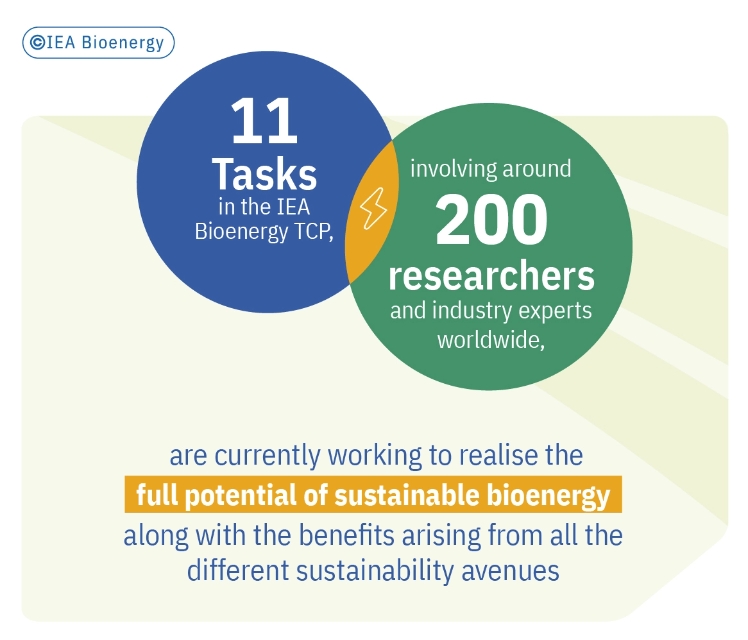
Different pathways may be pursued, yet the exceptional benefits of sustainable bioenergy must not be overlooked – no matter which scenario we decide to pursue.
Significantly improving the room for manoeuvre
To tackle the grand challenges of the 21st century and to counter the myriad uncertainties related to them, the top priority must be to implement and diversify sustainable solutions. Furthermore, given the time pressure caused by rapid increases in atmospheric GHG concentrations, the high technological readiness level (TRL) of many sustainable solutions, including modern bioenergy, must be acknowledged. High technological readiness goes hand in hand with established infrastructure, know-how, and experience that is already being—and should continue to be— deployed to ensure the complete phasing out of fossil fuels.
Supporting ecosystems, preventing forest degradation, and contributing to biodiversity
GHG intensity is the extent to which a service contributes to atmospheric GHG concentration. The reduced GHG intensity of modern bioenergy compared with that of fossil fuels has always been the major argument for the provision of heat, electricity, and fuels from biomass. Meanwhile, initial applications of carbon sequestration and storage have been providing negative CO2 emissions, in other words, they are actually removing CO2 from the atmosphere, for example through bioenergy carbon capture and storage (BECCS). Negative emissions are not only achievable through central, large-scale bioenergy plants and storage solutions; they can also come through decentralised, nature-based sequestration and storage, for example, afforestation. Furthermore, emissions can be retained for a foreseeable period through the circular use of biogenic CO2. Related practices can improve soil conditions and restore land, for instance biogas slurry being used as a biofertiliser or solid biomass gasification by-products being applied as soil conditioners (e.g., biochar).
Over the last decade, the debate has matured as to how biomass can be provided for energy in a sustainable and regenerative way that supports primary ecosystems and sources. With respect to agriculture and forestry under climate change stress, the term ecosystem services means, for example, the restoration and sustainable management of forests to prevent forest fires and mitigate pest infestations. Demand for sustainable biomass sources will shape not only sustainable forestry management but also sustainable agriculture. The provision of bioenergy, and the sustainability conditions required for its sourcing, will thus contribute to concerns for the biosphere being incorporated more responsibly into all human activities, including food and material provision.

Creating socio-economic benefits, supporting local producers, and generating jobs
Regional value creation is key to counteracting urbanisation and the rural exodus. The participation of the local population in bioenergy supply chains is already high; this is due to their multiple production and processing steps and also to different decision-making processes at different levels of governance—spanning from local communities, to districts, to the national and international levels.
Stabilising an energy system in transition
Over the next 10–20 years the rapid expansion of photovoltaic and wind power is expected to also lead to significant temporary surpluses and shortages in power provision in many countries. Imbalances in the power grid could be tackled over hours and days with battery and pump hydro storage. As bioenergy can be stored over longer periods, its importance will increase in the context of seasonal shortages, providing, for example, residential heating in wintertime when photovoltaic power for heat pumps is scarce. Furthermore, surpluses can be valorised, for example through the upgrading of biogas with hydrogen from excess renewable electricity.
In the longer run, bioenergy flexibility options for the power grid can also be supplemented with product flexibility, for example, combined heat and power or biomethane for industrial process heat, which can also be used as a chemical raw material. The unique versatility of possible applications for bioenergy technologies, their established supply chains, and their infrastructure will be decisive in terms of reacting to changing needs during the transition.
Supporting cleaner cooking solutions
About 2.8 billion people globally still lack access to clean cooking solutions and thus rely on traditional use of biomass in open fires. This traditional use of biomass is problematic, as open fires are inefficient and expose people (in particular women and children) to emissions of harmful air pollutants that can lead to respiratory diseases. Moreover, irresponsible gathering of wood can result in deforestation. Assuring access to cleaner cooking solutions is an integral part of a just transition and is addressed in Affordable and Clean Energy (SDG7), the goal of which is the phasing out of traditional open fire bioenergy by 2030.
Modern biomass stoves, bioethanol, and biogas are among several options for cleaner cooking. Compared to other cleaner cooking solutions, such as natural gas, liquified petroleum gas (LPG), or electricity, the use of biomass not only offers health benefits; it can also create income from biomass cultivation and ethanol production and enable the diversion of waste biomass to biogas production. Multilateral organisations such as the International Renewable Energy Agency (IRENA), the Global Bioenergy Partnership (GBEP), and the United Nations Industrial Development Organization (UNIDO) are actively involved in the roll-out of biomass-based clean cooking solutions.
- IEA Bioenergy (2016) Developing the Global Bioeconomy Technical, Market, and Environmental Lessons from Bioenergy LINK
- IEA Bioenergy Task 44 (2021) Technologies for Flexible Bioenergy LINK accessed 18/02/2022
- EA Bioenergy Task 44 (2021) Five Cornerstones to Unlock the Potential of Flexible Bioenergy LINK accessed 18/02/2022
- Project GAIA Energy Revolution LINK accessed 18/02/2022
- United Nations Department of Economic and Social Affairs Sustainable Development, SDG Goal 7 Ensure access to affordable, reliable, sustainable and modern energy for all LINK accessed 18/02/2022
